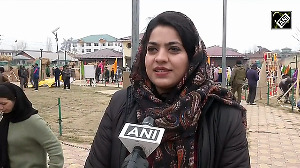'The 2017 Doklam stand-off in Bhutan, the 2018 Maldives crisis, and the 2020 Nepal Kalapani border dispute shows how Beijing has shot off these countries' shoulders to target India.'

In a new report on how China engages South Asia, Constantino Xavier, Research Fellow, Centre for Social and Economic Progress, and Jabin Jacob, Associate professor, Department of International Relations and Governance Studies, Shiv Nadar University, have mapped Chinese strategies to establish itself in the area.
The report is based on research by South Asian scholars.
"It should be clear that India-China 'rivalry' and 'competition' are not episodic or contextual, but structural," Xavier and Jacob tell Aditi Phadnis/Business Standard.
India's rivalry with China in South Asia is spoken about only in hushed tones.
Despite Indian assertions that it is not in competition in a region it is thought to have long dominated, it is China, not India, that is mediating between Myanmar and Bangladesh on the Rohingyas.
There are other examples in your report.
It is not exactly true that India's rivalry with China is spoken of only in hushed tones.
The Indian strategic community is quite vocal about this reality, and this rivalry is not limited to South Asia.
The government will, of course, have its own manner of communicating, but both its statements and actions need to be considered in conjunction with what Indian analysts are saying.
It should be clear that 'rivalry' and 'competition' are not episodic or contextual, but structural.
Why has India fallen behind in the competition to capture mindspace in South Asia? How has China managed this?
Falling behind is relative. While India has been cognisant of China's greater economic weight in the neighbourhood, it has been slow to acknowledge and respond to China's greater ability to exercise diplomatic influence with its neighbours as well as a political influence within them that comes with greater economic capacity.
This has been accompanied by large numbers of State media personnel also stationed in these countries, often fluent in local languages.
How many Indian newspapers have correspondents in all the South Asian capitals?
Yet, the China novelty advantage is also beginning to fade away.
Most South Asians beyond India still look at China as a land of infinite resources and progress, but as they get closer, the grass is also looking less green than initially imagined.
The case studies from Nepal and Sri Lanka show how China is also increasingly involved in political affairs, shaping laws and regulations, and using social media to push narratives.
It's becoming increasingly difficult for China to present itself as an exceptional power that is purely interested in developmental partnerships.
As China adopts a more aggressive global posture, do you think its sense of competition with India in South Asia will increase? Or decrease?
Competition is bound to increase because it is structural. Countries in the region are also keen to balance and hedge, seeking to maximise their gains from Sino-Indian competition by playing one against the other.
In South Asia, China and India are locked into a boxing match with multiple rounds, no knockout, and a jury that is nudging them against each other.
The question is whether this can escalate into conflict in situations where China and India undermine each other in third countries.
The 2017 Doklam stand-off in Bhutan, the 2018 Maldives crisis, and the 2020 Nepal Kalapani border dispute shows how Beijing has shot off these countries' shoulders to target India.
There is little hope left in Kathmandu, Dhaka, or Colombo that China and India can cooperate on regional issues, for example, the Trans-Himalayan Economic Corridor.
But there may be sectors where India and China are comfortable coexisting or coordinating.
China's infrastructure projects can be beneficial for India's interests, even in the case of the infamous Hambantota harbour, which has been used to transship cars and gas to India.
India, of late, has tried to stay out of regime change games in South Asian politics, unlike China. Should this policy continue?
India will obviously behave very differently from a one-party State like China.
India's history in the neighbourhood shows it has an interest in democratic systems and deploys diplomatic, economic, and even military power to support pluralism, as it did in East Pakistan, Nepal, and Sri Lanka.
This is very different from the Chinese preference for the authoritarian concentration of power and explains why Chinese policymakers are frustrated and bewildered by the fluid, or what they see as 'chaotic', democratic cultures in South Asia.
India is learning to lean back and avoid micromanagement, but China is still figuring that out, as seen during the 2021 Nepal crisis.
Yet in some other cases, maybe in Bangladesh over the next few months, Chinese and Indian positions may sometimes also align in favour of regime continuity and stability despite democratic shortcomings, helping Dhaka to fend off Western pressures.
Feature Presentation: Aslam Hunani/Rediff.com












 © 2025
© 2025